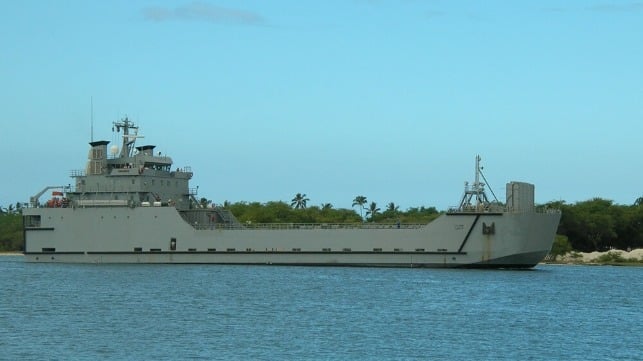U.S. Navy Changes Tack on Marine Corps Landing Ship

The U.S. Navy has quietly walked back goals for a high-end, well-armed medium landing ship for the Marine Corps, and has put out a request for information for existing designs that could be used for the same purpose. The decision aligns with budgetary pressures and with the Marine Corps' request for a small-size, low-cost landing ship built in large enough numbers to be useful in a conflict in the Pacific.
The request for information is focused solely on vessel designs that have been built before and would only require small modifications to meet the Navy's needs. The RFI provides limited guidelines about what kind of vessel the service seeks, except that the Navy is looking for a minimum cargo capacity of 300 short tons and an overall length of less than 400 feet. Requirements for self-defense or survivability - two areas where high Navy standards often lead to higher costs - are absent from the request.
Among currently-serving vessels in the U.S. inventory, the specifications align best with the Besson-class landing ships operated by the U.S. Army's Watercraft Systems division. The lengthened Robert T. Kuroda-subclass is about 320 feet long and can deliver 900 short tons over the beach (or 2,000 short tons to a developed pier). The Robert T. Kuroda was nearly sold at auction in 2019 during an aborted attempt to sell down the Army's waterborne assets, but the sale was quickly canceled once publicized.
Two of the Army's Besson-class vessels, General Frank S. Besson and James A. Loux, were deployed to the Mediterranean in 2024 for the attempt to establish a floating pier off the coast of Gaza. These ships are designed with drive-through ramps at bow and stern, allowing rapid loading and unloading for the Joint Logistics Over the Shore (JLOTS) causeway system.
The U.S. Navy is not alone in seeking large-volume landing ship capabilities. Open-source satellite imagery suggests that a state-owned yard in China is building landing barges with jackup legs and long bridging ramps - long enough to span the surf zone and create a temporary pier on a beachhead. Combined with China's fleet of dual-purpose ro/ro ferries - civilian in everyday use, but formally linked with the PLA's amphibious warfare training - the new landing barges could provide China's marines with rapid, high-volume access at unimproved beach sites.
Analysis of GEOINT on 08 January 2025 shows new possible amphibious operations support vessels at the Guangzhou shipyard in China. https://t.co/epfzHD3Daa
— AllSource Analysis (@AllSourceA) January 10, 2025
Spotlight Report - Critical intelligence delivered to your inbox. https://t.co/n0XDPQMZj2#GEOINT #China #Guangzhou pic.twitter.com/EElgZv2rM2
